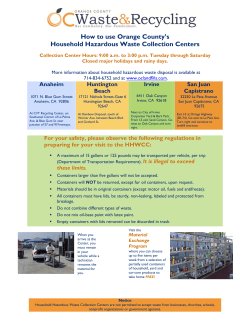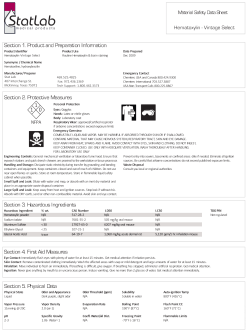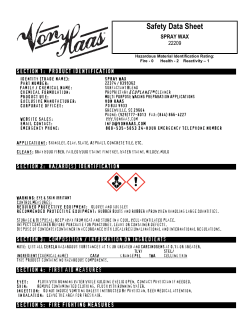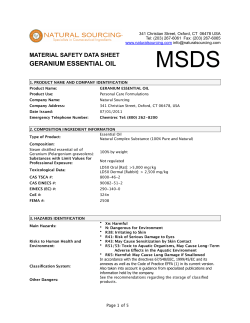
Disposal of Pharmaceuticals, and their empty - Bio
Disposal of Pharmaceuticals, and their empty containers, in the Workplace Prepared by Bio-Team Mobile LLC There is a lot of misinformation being circulated about disposal of pharmaceuticals ever since it was reported that, in some areas in the US, there has been pharmaceutical contamination of the drinking water. It is true that the Environmental Protection Agency (EPA) has found traces of prescription drugs in the water supply and, as a result, did a study (2008) of how healthcare providers dispose of expired and partially-empty containers of pharmaceuticals. Because of this study, some companies are attempting to frighten people into buying a unique service that treats all office pharmaceuticals as hazardous, requiring a more expensive disposal option. Best management practice: The ideal method of drug disposal is to use the entire drug supply in your possession at its recommended levels for its intended purpose. In reality, this is not always possible. The question then is, how should pharmaceuticals and empty containers that formerly held pharmaceuticals be disposed of to protect our health and the environment? The following is a Quick Reference Guide as to how to properly and safely dispose of pharmaceuticals. A more detailed explanation follows the Quick Reference Guide. Quick Reference Guide for Proper Drug Disposal Bio-Team Mobile LLC is committed to creating a safer world for all of us at a price we can afford. Therefore, after studying the regulations and recommendations, the following is what we believe are the best management practices for disposing pharmaceuticals. There are two broad categories of pharmaceuticals: over the counter (OTC) drugs and prescription drugs. Prescription drugs are broken down into three groups: common (non-controlled, non-hazardous) prescriptions, controlled substances (some also called narcotics), and hazardous drugs. Over the Counter (OTC) Drug Disposal • • Place all unused OTC drugs in the regulated medical (red bag) waste box. Empty containers (containers that formerly held a pharmaceutical) can be discarded in the trash. Prescription Drug (Non-Controlled, Non-Hazardous) Disposal • • • Place all unused drugs in the regulated medical (red bag) waste box. Empty containers can be discarded in the trash. However, if there is a concern that there may be some residue remaining in the container, put the empty container into the regulated medical (red bag) waste box. All sharps must always go into a sharps container. 1 Bio-Team Mobile LLC Best Practices for Disposing OTC and Non-Controlled, Non-Hazardous Prescription Drugs: Use the regulated medical (red bag) waste box provided by Bio-Team Mobile LLC to dispose of your accumulated, unused, or expired drugs. When the box is full or reaches 40 pounds, close the box and write “Incinerate Only” next to the block for your address label. Bio-Team Mobile LLC will then transport the waste, along with any other infectious waste in your office, and have it incinerated. Empty containers can be discarded in the trash. All sharps must always go into a sharps container. Controlled substances Disposal • There are two ways to dispose of controlled substances: 1. Take it to a facility with a “collection receptacle” such as a pharmacy, hospital with an in-house pharmacy, Long Term Care Facility (LTCF) with a collection receptacle, or law enforcement office. 2. Use a mail-back service. When using a mail-back service, the mailer must be obtained directly from the mail-back service company since the packaging is tightly regulated. • Empty containers should be disposed in the regulated medical (red bag) waste box. Medicinal Patches • • The preferred method of disposal is to take the patch to a collection receptacle or to use a mail-back service. If a collection receptacle is not available, the used patches can also be disposed in the regulated medical (red bag) waste box because, after they are used, they are considered empty and are no longer a controlled substance. Bio-Team Mobile LLC Best Practices for Disposing Controlled Drugs (Narcotics) and Medicinal Patches: Bio-Team Mobile LLC cannot transport controlled substances. Controlled substances must be taken to a collection receptacle or mailed through a mail-back service. However, empty containers and used patches can be disposed in the regulated medical (red bag) waste box. Never put unused controlled substances into the regulated medical (red bag) waste box. Hazardous Drug Disposal • Hazardous pharmaceuticals are divided into three general divisions: highly toxic drugs that are on the PList, less toxic drugs on the U-List, and drugs labeled as hazardous because they are flammable, corrosive, or reactive. 2 o • • The majority of the hazardous drug waste in a medical facility or office is not on the P or U list. (These lists are found at 40 CFR 261.31-.33. The lists are for all hazardous chemicals, not just drugs.) The rules regarding record keeping, storage, and how long waste can be kept changes depending on the amount of hazardous waste a company generates. o Disposal of unused, expired, or partially-used drugs need to be in Department of Transportation (DOT) approved containers, properly labeled, and manifested. Empty containers of hazardous drugs can be put in the regulated medical (red bag) waste box if they have been emptied as described by the code. (The codes are explained in the next section.) o The only exception is empty containers that held P-listed drugs. Because of the high toxicity of P-List drugs, Bio-Team Mobile LLC recommends that the package be safely disposed as hazardous waste. Bio-Team Mobile LLC Best Practices for Disposing Hazardous Drugs: Bio-Team Mobile LLC can tell you which list a particular hazardous drug is on and which code to follow for proper handling. We will provide the correct DOT-approved containers, labels, and manifest for the disposal of all hazardous drugs. We will also transport all hazardous waste to a properly-licensed disposal facility. Empty containers of hazardous drugs can be put in the regulated medical (red bag) waste box if they have been emptied as described by the code. The only exception is empty containers that held P-listed drugs. Because of the high toxicity of P-List drugs, Bio-Team Mobile LLC recommends that the package be safely disposed as hazardous waste. 3 Disposal of Pharmaceuticals, and their empty containers, in the Workplace Detailed Description of the Quick Reference Guide Let’s begin with a quick overview. There are two general divisions of drugs in common use: over the counter (OTC) drugs and prescription drugs. Prescription drugs are divided into three additional categories: relatively safe drugs routinely prescribed to treat numerous illness (also described as non-controlled and nonhazardous), controlled substances (some also called narcotics), and hazardous drugs. The Environmental Protection Agency (EPA) has estimated the number of hazardous drugs to be about 5% of all drugs. Source: Unused Pharmaceuticals in the Health Care Industry, August 2008 Bio-Team Mobile LLC is committed to creating a safer world for all of us at a price we can afford. Therefore, after studying the regulations and recommendations, the following is what we believe are the best management practices for disposing pharmaceuticals. While reading, keep in mind that there is a distinction that must be made between unused drugs which need to be disposed and empty containers which need to be disposed. The disposal of these two is sometimes different. Empty containers such as vials, syringes, IV Bags and tubing are considered empty when following the practices commonly used to remove the materials from the container that the pharmaceutical is shipped in. Over the Counter (OTC) Drug Disposal Even though OTC drugs can be disposed in the trash, a better practice in a professional office is to dispose of the drugs in the regulated medical (red bag) waste box to be incinerated. Any empty container can be discarded in the trash. Prescription Drug Disposal 1. Non-Controlled, Non-Hazardous Drug Disposal Prescription drugs should be disposed of in the regulated medical (red bag) waste box. Any containers that are empty can be discarded in the regular trash provided there are no sharps attached. All sharps must always go into a sharps container before being put into the regulated medical (red bag) waste box. If there is concern that there may be some residue remaining in the container, best management practice is to put the empty container into the regulated medical (red bag) waste box. Bio-Team Mobile LLC Best Practices for Disposing OTC and Non-Controlled, NonHazardous Prescription drugs: Use the regulated medical (red bag) waste box provided by Bio-Team Mobile LLC to dispose of your accumulated, unused, or expired drugs. When the box is full or reaches 40 pounds, close the box and write “Incinerate Only” next to the block for your address label. Bio-Team Mobile LLC will then transport the waste, along with any other infectious waste in your office, and have it incinerated. 4 Empty containers can be discarded in the trash. All sharps must always go into a sharps container. Some confusion about whether or not pharmaceuticals should be disposed in regulated medical (red bag) waste boxes arose after the following was published: “As a best management practice, unused pharmaceuticals should not be disposed of with biohazardous waste or red bag waste. Bio hazardous waste is typically sterilized (e.g., in an autoclave) prior to disposal in landfills. The temperature achieved during autoclaving is insufficient to destroy most pharmaceutical ingredients. During sterilization, wastewater potentially containing pharmaceuticals may be generated and discharged to the sewer, through which it reaches waterways. EPA’s goal is to keep pharmaceuticals out of U.S. waters.” Source: Guidance Document: Best Management Practices for Unused Pharmaceuticals at Health Care Facilities, 26 August 2010 Therefore, you may be asking, why does Bio-Team Mobile LLC recommend putting your unused drugs in the regulated medical (red bag) waste if EPA best practices, as noted above, say not to? The answer is simple. The authors of the above article are making an assumption that the waste is being autoclaved. However, the boxes of waste with drugs that Bio-Team Mobile LLC picks up will be incinerated as recommended by the EPA. We believe it is much simpler—and more cost effective—to have only one way of disposing your medical waste whenever possible. 2. Controlled Drugs Disposal Controlled drugs are tightly regulated by the Drug Enforcement Administration (DEA). These drugs are divided into five schedules. Schedule I are illegal drugs with no medicinal use. Schedule II through V have medicinal use but are addictive, with schedule II being the most addictive. It is impossible to legally have controlled substances unless you are a registrant with the DEA or are an ultimate user. A registrant is a pharmacy, practitioner, Research University, or anyone licensed to legally have controlled substances. The Controlled Substance Act (CSA) defines an ultimate user as “a person who has lawfully obtained, and who possesses, a controlled substance for his own use or for the use of a member of his household or for an animal owned by him or a member of his household.” Registrants and ultimate users have clearly defined guidelines in how to dispose of unused product and must abide by those requirements. The law is in Title 21CFR 1317.01 - 1317.85 subpart A, B and C. There are a number of questions to be addressed by clinics, nursing homes, and offices that dispense and use controlled substances within their facility. The questions are as follows: 1. What should be done with any controlled substance prescribed to an ultimate user that remains either because the ultimate user’s treatment is completed, the ultimate user moves to a Long Term Care Facility (LTCF) without take the controlled drugs along, or the ultimate user dies? Answer: There are two ways to dispose of controlled substances. First, it can be taken to a facility with a “collection receptacle” such as a pharmacy, hospital with an in-house pharmacy, LTCF with a collection receptacle, or law enforcement office. The second option is to use a mail-back service. When using a mail-back service, the mailer must be obtained directly from the mail-back service since the packaging is tightly regulated.. Source: DEA, Website “General Public Fact Sheet” 5 2. Can a LTCF dispose of pharmaceutical controlled substances on behalf of a person who resides or has resided at their facility? Answer: Yes. If someone dies while in lawful possession of controlled substances, any person lawfully entitled to dispose of the deceased’s property may dispose of the deceased’s pharmaceutical and controlled substances. The controlled substances must be transferred to a collection receptacle within three business days. Source: DEA, Website “Long-Term Care Facility Fact Sheet” 3. What should be done with empty containers after the drug is used? (This applies to both a registrant and ultimate user.) Answer: Empty containers should be disposed in the regulated medical (red bag) waste box. Empty containers such as vials, syringes, IV Bags, and tubing are considered empty if the entire drug has “been removed that can be removed using the practices commonly employed to remove materials from that type of container, e.g., pouring, pumping, and aspirating.” For example, a syringe is considered empty when the plunger in a syringe is fully depressed. The IV bag and tubing is considered empty when the drug has drained from the container and no more than 3% of the drug is remaining. Source: University of Pittsburg, Controlled Substance Information “Frequently Asked Questions” a. Medicinal Patches Disposal A unique area within the controlled substance rules are patches prescribed to ultimate users to dispense medicine. These patches, even after removed from patients, have high levels of the drug remaining which causes them to still be dangerous to the general population. Therefore, the preferred method of disposal is to take the patch to a collection receptacle or to use a mail-back program. If a collection receptacle is not available, the US Food and Drug Administration (FDA) recommends that when the patch is removed, the patch should be folded in half with the sticky sides together and then flushed down the toilet. (Source: DEA, Website “Long-Term Care Facility Fact Sheet”) A better practice is to place the used patches in the regulated medical (red bag) waste box to be incinerated. This is permissible because, after patches are used, they are considered “empty.” Source: letter from EPA August 23, 2010 All organizations should have a strict protocol in place for handling controlled substances, including medicinal patches, from administration to disposal. The accepted regiment is to have two employees present whenever a controlled substance is in a person’s possession until it is administered, placed in a disposal receptacle, or locked up. Bio-Team Mobile LLC Best Practices for Disposing Controlled Drugs (Narcotics) and Medicinal Patches: Bio-Team Mobile LLC cannot transport controlled substances. Controlled substances must be taken to a collection receptacle or mailed through a mail-back service. However, empty containers and used patches can 6 be disposed in the regulated medical (red bag) waste box. Never put unused controlled substances into the regulated medical (red bag) waste box. 3. Hazardous Drug Disposal Three areas need to be understood in order to determine how hazardous drugs and containers of hazardous drugs ought to be disposed. First, one must understand the definition of a hazardous drug. Second, one must know how to determine which drugs are hazardous. Third, one must know how many hazardous drugs (in other words, the total size or amount) their company uses and/or disposes. What makes a drug hazardous? A drug is hazardous if it has one or more of the following characteristics: 1. 2. 3. 4. Ignitable: It catches fire under certain conditions. Corrosive: It has a pH >2 or <12.5. Reactive: When mixed with water it reacts, explodes or gives off fumes. Toxic: It is harmful or fatal when ingested or absorbed. And/or It is listed on one of four lists of hazardous chemicals. These lists are: 1. 2. 3. 4. F-list: Waste from a non-specific source. K-list: Waste from a specific source or specific industry. P-list: Waste that is acutely toxic. U-list: Waste that is toxic. Source: These lists are found at 40 CFR 261.31-.33 The list is for all hazardous chemicals, not just drugs. How does one determine if a drug is a hazardous drug? There are a number of ways to determine if a drug is a hazardous drug: 1. National Institute for Occupational Safety and Health (NIOSH) publishes a list of hazardous drugs. Right now, there are around 180 drugs on that list used mostly in cancer or pain management treatment. The list is on their website. 2. The manufacturer or distributor should be able to tell you. 3. The drug representative who sells the product should know. 4. Bio-Team Mobile LLC can tell you. How much waste does your company generate? 7 There are three sizes of companies. As the generator increases in quantity of waste generated, the rules regarding record keeping, storage, and how long waste can be kept changes. The three types of generators, and a partial summary of the rules regarding waste accumulation and storage, is explained below. 1. Conditionally Exempt Small Quantity Generator (CESQG) a. This generator produces 220 pounds or less of hazardous waste and/or 2.2 pounds or less of acute hazardous waste per month. b. No EPA number is required. c. Waste can be accumulated and stored where it is generated until accumulation container is full. d. Manifest all shipments of waste. 2. Small Quantity Generator (SQG): A partial summary a. This generator produces between 220 and 2200 pounds of hazardous waste and/or 2.2 pounds or less of acute hazardous waste. b. The company must register with the EPA and receive an identification number. c. Accumulation containers must be properly labeled and marked with the words “Hazardous Waste”. d. Can accumulate up to 55 gallons of waste at the point of generation, called a satellite container or location, or 1 quart of acute hazard. e. After moving waste to a central accumulation area, it can be stored for 180 days (270 days if shipped over 200 miles). f. Manifest all shipments of waste. 3. Large Quantity Generator (LQG): A partial summary a. This generator produces more than 2200 pounds of hazardous waste and more than 2.2 pounds of acute hazardous waste. b. The company must register with the EPA and receive an identification number. c. Accumulation containers must be properly labeled and marked with the words “Hazardous Waste”. d. Can accumulate up to 55 gallons of waste at the point of generation called a satellite container or location or 1 quart of acute hazard. e. After moving waste to a central accumulation area, it can be stored for 90 days. f. Manifest all shipments of waste. The disposal of empty containers that held hazardous drugs The empty containers of hazardous drugs can be put in the medical (red bag) waste box if they have been emptied as described by the code: “(i) All wastes have been removed that can be removed using the practices commonly employed to remove materials from that type of container, e.g., pouring, pumping, and aspirating, and (ii) No more than 2.5 centimeters (one inch) of residue remain on the bottom of the container or inner liner, or (iii) No more 8 than 3 percent by weight of the total capacity of the container remains in the container or inner liner if the container is less than or equal to 119 gallons in size.” Source: 40 CRF 267.7 P-listed drugs are the exception. Containers which held P-listed acutely hazardous drugs are considered empty as described by this code: “(i) The container or inner liner has been triple rinsed using a solvent capable of removing the commercial chemical product or manufacturing chemical intermediate; (ii) The container or inner liner has been cleaned by another method that has been shown in the scientific literature, or by tests conducted by the generator, to achieve equivalent removal; or (iii) In the case of a container, the inner liner that prevented contact of the commercial chemical product or manufacturing chemical intermediate with the container, has been removed.” Source: 40 CRF 267.7 Since the packaging of P-listed drugs that is touched by the product is very small it is the recommendation of Bio-Team Mobile LLC that the package be safely disposed as hazardous waste. Bio-Team Mobile LLC Best Practices for Disposing Hazardous Drugs: Bio-Team Mobile LLC can tell you which list a particular hazardous drug is on and which code to follow for proper handling. We will provide the correct DOT-approved containers, labels, and manifest for the disposal of all hazardous drugs. We will also transport all hazardous waste to a properly-licensed disposal facility. Empty containers of hazardous drugs can be put in the regulated medical (red bag) waste box if they have been emptied as described by the code. The only exception is empty containers that held P-listed drugs. Because of the high toxicity of P-List drugs, Bio-Team Mobile LLC recommends that the package be safely disposed as hazardous waste. In Summary Most medical offices, dental offices, clinics, LTCF, or labs do not have controlled substances or hazardous drugs to contend with. Therefore Bio-Team Mobile LLC recommends that all (except controlled substances or the 5% that are hazardous drugs) unused drugs, expired drugs, or partially-used containers of pharmaceuticals be disposed in the regulated medical (red bag) waste box to be picked up by Bio-Team Mobile LLC and incinerated. When unused or expired drugs are placed in one of our boxes please mark it “incinerate” above your client label. 9
© Copyright 2025









